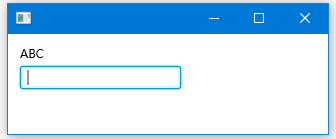JavaFX绑定
JavaFX绑定同步两个值:当依赖变量更改时,其他变量更改。
要将属性绑定到另一个属性,请调用bind()方法,该方法在一个方向绑定值。 例如,当属性A绑定到属性B时,属性B的更改将更新属性A,但不可以反过来。
绑定选项
JavaFX提供了许多绑定选项,以便在域对象和GUI控件中的属性之间进行同步。
我们可以在JavaFX的Properties API中使用以下三种绑定策略:
- Java Bean上的双向绑定
- 与Fluent API的高级绑定
- 使用javafx.beans.binding定义绑定对象进行低级绑定。
双向绑定
双向绑定绑定相同类型的属性,并同步两侧的值。当使用bindBidirectional()方法双向绑定时,需要两个属性都必须是可读/写的。
以下代码显示如何在firstName属性和字符串属性变量之间进行双向绑定
import javafx.beans.property.SimpleStringProperty;
import javafx.beans.property.StringProperty;
public class Main {
public static void main(String[] args) {
User contact = new User("Jame", "Bind");
StringProperty fname = new SimpleStringProperty();
fname.bindBidirectional(contact.firstNameProperty());
contact.firstNameProperty().set("new value");
fname.set("新绑定名称值");
System.out.println("firstNameProperty = " + contact.firstNameProperty().get());
System.out.println("fname = " + fname.get());
}// @ W WW .yI iB AI.c o M
}
class User {
private SimpleStringProperty firstName = new SimpleStringProperty();
private SimpleStringProperty lastName = new SimpleStringProperty();
public User(String fn, String ln) {
firstName.setValue(fn);
lastName.setValue(ln);
}
public final String getFirstName() {
return firstName.getValue();
}
public StringProperty firstNameProperty() {
return firstName;
}
public final void setFirstName(String firstName) {
this.firstName.setValue(firstName);
}
public final String getLastName() {
return lastName.getValue();
}
public StringProperty lastNameProperty() {
return lastName;
}
public final void setLastName(String lastName) {
this.lastName.setValue(lastName);
}
}
上面的代码生成以下结果。
firstNameProperty = 新绑定名称值 fname = 新绑定名称值
高级别绑定
我们也可以使用JavaFX流利的API来绑定属性。API使用类似英语的方法名称对属性执行操作。 例如,multiply(),divide(),subtract(),isEqualTo(),isNotEqualTo(),concat()。 请注意,方法名称中没有get或set。当链接API在一起时可以写代码,就像类似于写英文句子,例如,width().multiply(height()).divide(2)。
以下代码显示如何创建表示计算矩形面积的公式的属性。
它通过使用javafx.beans.binding.IntegerExpression接口中的fluent API来执行高级绑定。
该代码使用multiply()方法,该方法返回包含计算值 -NumberBinding。
这个绑定是延迟评估求值的,这意味着乘法不会执行计算,除非通过get()或getValue()方法调用属性的值。
import javafx.beans.binding.NumberBinding;
import javafx.beans.property.IntegerProperty;
import javafx.beans.property.SimpleIntegerProperty;
public class Main {
public static void main(String[] args) {
// Area = width * height
IntegerProperty width = new SimpleIntegerProperty(10);
IntegerProperty height = new SimpleIntegerProperty(10);
NumberBinding area = width.multiply(height);
System.out.println(area.getValue());
}
}
上面的代码生成以下结果。
100
低级别绑定
当对NumberBinding类进行子类化时,使用低级别绑定,例如Double类型的DoubleBinding类。
在DoubleBinding类的子类中,我们覆盖它的computeValue()方法,以便可以使用运算符(例如*和-)来制定复杂的数学方程计算。
高级绑定使用如multiply(),subtract()等方法,而低级绑定使用诸如*和-等运算符。
以下代码显示如何为公式创建低级别绑定,来计算矩形的面积。
import javafx.beans.binding.DoubleBinding;
import javafx.beans.property.DoubleProperty;
import javafx.beans.property.SimpleDoubleProperty;
public class Main {
public static void main(String[] args) {
DoubleProperty width = new SimpleDoubleProperty(2);
DoubleProperty height = new SimpleDoubleProperty(2);
DoubleBinding area = new DoubleBinding() {
{
super.bind(width, height); // initial bind
}
@Override
protected double computeValue() {
return width.get() * height.get();
}
};
System.out.println(area.get());
}
}
上面的代码生成以下结果。
4.0
UI控件和域模型之间的绑定
在JavaFX中,UI控件和域模型之间的数据绑定很容易。以下代码显示如何创建登录对话框并绑定用户域对象。
首先,我们定义域对象,它是描述用户名和密码的JavaFX JavaBean。
class User {
private final ReadOnlyStringWrapper userName;
private StringProperty password;
public User() {
userName = new ReadOnlyStringWrapper(this, "userName", "ABC");
password = new SimpleStringProperty(this, "password", "");
}
public final String getUserName() {
return userName.get();
}
public ReadOnlyStringProperty userNameProperty() {
return userName.getReadOnlyProperty();
}
public final String getPassword() {
return password.get();
}
public StringProperty passwordProperty() {
return password;
}
}
我们创建了两个UI控件,一个用于使用Text控件显示用户名,另一个是PasswordField字段控件,它将输入值绑定到域对象(User)中的password字段。
Text userName = new Text();
userName.textProperty().bind(user.userNameProperty());
PasswordField passwordField = new PasswordField();
passwordField.setPromptText("Password");
user.passwordProperty().bind(passwordField.textProperty());
在更改侦听器中为passwordField字段文本值属性设置BooleanProperty访问权限。
passwordField.textProperty().addListener((obs, ov, nv) -> {
boolean granted = passwordField.getText().equals(MY_PASS);
accessGranted.set(granted);
if (granted) {
primaryStage.setTitle("");
}
});
在enter键点击事件中访问BooleanProperty accessGranted。
// user hits the enter key
passwordField.setOnAction(actionEvent -> {
if (accessGranted.get()) {
System.out.println("granted access:"+ user.getUserName());
System.out.println("password:"+ user.getPassword());
Platform.exit();
} else {
primaryStage.setTitle("no access");
}
});
完整的源代码如下所示。
import javafx.application.Application;
import javafx.application.Platform;
import javafx.beans.property.BooleanProperty;
import javafx.beans.property.ReadOnlyStringProperty;
import javafx.beans.property.ReadOnlyStringWrapper;
import javafx.beans.property.SimpleBooleanProperty;
import javafx.beans.property.SimpleStringProperty;
import javafx.beans.property.StringProperty;
import javafx.scene.Group;
import javafx.scene.Scene;
import javafx.scene.control.PasswordField;
import javafx.scene.layout.VBox;
import javafx.scene.text.Text;
import javafx.stage.Stage;
// @ w Ww .yi iB A i. C o M
public class Main extends Application {
private final static String MY_PASS = "passwd";// 初始密码
private final static BooleanProperty accessGranted = new SimpleBooleanProperty(false);
@Override
public void start(Stage primaryStage) {
User user = new User();
Group root = new Group();
Scene scene = new Scene(root, 320, 100);
primaryStage.setScene(scene);
Text userName = new Text();
userName.textProperty().bind(user.userNameProperty());
PasswordField passwordField = new PasswordField();
passwordField.setPromptText("Password");
user.passwordProperty().bind(passwordField.textProperty());
// user hits the enter key
passwordField.setOnAction(actionEvent -> {
if (accessGranted.get()) {
System.out.println("granted access:" + user.getUserName());
System.out.println("password:" + user.getPassword());
Platform.exit();
} else {// @ WW w .yIIB A i.c OM
primaryStage.setTitle("no access");
}
});
passwordField.textProperty().addListener((obs, ov, nv) -> {
boolean granted = passwordField.getText().equals(MY_PASS);
accessGranted.set(granted);
if (granted) {
primaryStage.setTitle("");
}
});
VBox formLayout = new VBox(4);
formLayout.getChildren().addAll(userName, passwordField);
formLayout.setLayoutX(12);
formLayout.setLayoutY(12);
root.getChildren().addAll(formLayout);
primaryStage.show();
}
public static void main(String[] args) {
launch(args);
}
}
class User {
private final ReadOnlyStringWrapper userName;
private StringProperty password;
public User() {
userName = new ReadOnlyStringWrapper(this, "userName", "ABC");
password = new SimpleStringProperty(this, "password", "");
}
public final String getUserName() {
return userName.get();
}
public ReadOnlyStringProperty userNameProperty() {
return userName.getReadOnlyProperty();
}
public final String getPassword() {
return password.get();
}
public StringProperty passwordProperty() {
return password;
}
}
上面的代码生成以下结果。

在上面的输入框中输入密码:passwd完成后,得到以下输出结果 -
granted access:ABC password:passwd
欢迎任何形式的转载,但请务必注明出处,尊重他人劳动共创优秀实例教程
转载请注明:文章转载自:代码驿站 [http:/www.codeinn.net]
本文标题:JavaFX绑定
本文地址:http://www.codeinn.net/javafx/1135.html



